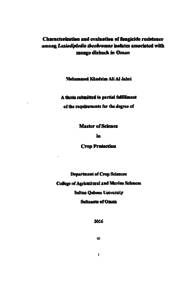Document
Characterization and evaluation of fungicide resistance among Lasiodiplodia theobromae isolates associated with mango dieback in Oman.
Publisher
Sultan Qaboos University
Gregorian
2016
Language
English
Subject
English abstract
Dieback is one of the most common diseases of mango in different parts of the world, including Oman. Despite efforts to control the disease using different fungicides, disease incidence is still high. This study causal agents of the disease in two farms in Oman and the degree of sensitivity of fungal isolates to four common fungicides. The survey showed association of dieback symptoms with most mango cultivars in the farms, with some cultivars having higher disease incidence. Isolations from 40 mango trees developing dieback symptoms revealed association of Lasiodiplodia spp. with 95% of the trees. and Fusarium spp. were isolated from only 10% and 8% of the trees, respectively. Further identification of 67 Lasiodiplodia isolates using sequences of the internal transcribed spacer region of the ribosomal RNA gene (ITS rRNA) and sequenceof the translation elongation factor gene (EF) revealed that all isolates areLasiodiplodiatheobromae. Pathogenicity test of two randomly selected isolates of L. theobromae on 'Amerbally' and 'Omani' mango cultivars showed that the four-month old seedlings started showing dieback symptoms within two weeks of noculation. Testing sensitivity of 28 randomly selected L. theobromae isolates to four common fungicides showed that the EC50 levels of the isolates were in the range of 0.01-8.75. (avg. 0.54 mg 1) for iprodione, er 0.1-242.8 (111.6 mg 1!) for copper oxychloride, 40.3-738.1 (avg. 229.3 mg 1!) for copper hydroxide and 0.1 to over 1000 (avg. > 1000 mg 1!) for thiophanate-methyl. The current study shows the association of L. curi theobromae with dieback symptoms and the development of resistance to some fungicides, especially thiophanate-methyl, Development of resistance to fungicides could be one of the main reasons behind the reduction in the efficacy of managing dieback in the studied farms.
Member of
Resource URL
Arabic abstract
الموت الرجعي هو واحد من أكثر الأمراض شيوعا في أشجار المانجو وذلك في أجزاء مختلفة من العالم، بما في ذلك سلطنة عمان. وعلى الرغم من الجهود المبذولة للسيطرة على هذا المرض باستخدام مبيدات الفطريات المختلفة، الا إن نسبة حدوث هذا المرض لا تزال مرتفعة
تشتمل هذه الدراسة على تشخيص لهذا المرض وذلك من خلال تطبيقها على مزرعتين مختلفتين في عمان حيث تم قياس درجة حساسية الفطريات المعزولة من هذه الأشجار على أربعة أنواع من مبيدات الفطريات الأكثر استخداما. وقد أظهر المسح وجود أعراض الموت التراجعي على معظم أصناف المانجو في المزرعتين. تم عزل الفطريات من 40 شجرة مانجو مصابة بأعراض الموت التراجعي. وأظهرت النتائج أن 95% من الفطريات هي Lasiodiplodia spp. كما تم ايضا عزل .Alternaria and Fusarium spp من أشجار المانجو بنسبة %8 و%10 على التوالي. كما تم التعرف على 67 عزلة Lastodiplodia من الفطريات المعزولة وذلك باستخدام تسلسل المنطقة على الفواصل الداخلية من جين (ITS rRNA) وجین (EF) وقد كشفت أن جميع العزلات هي .Lastodiplodia theobromae.كما أظهر اختبار العدوى الصناعية على نوعين من الشتلات (امربالي وصنف عماني ) باستخدام عزلتين مختلفتين للمرض والتي تم اختيارها عشوائيا من L . theobromae ظهور أعراض الذبول على الشتلات التي عمرها أربعة أشهر في غضون أسبوعين من العدوى.
عند تقيم حساسية أربعة مبيدات فطرية على 28 L . theobromae عزلة تم اختيارها عشوائيا أظهرت أن مستويات EC50 من العزلات في نطاق 0 . 1-8 . 75 (متوسط. 0 . 54 ملغ لكل لتر) للابروديون، 0 . 1-242 . 8 (111 . 6 ملغ لكل لتر) لأوكسي كلوريد النحاس، 40 . 3 -738 . 1 متوسط. 229 . 3 ملغم لكل لتر) لهيدروكسيد النحاس و 0 . 1 إلى أكثر من 1000 (متوسط. < 1000 ملغ لكل لتر) للثيوفانيت ميثيل. تظهر الدراسة الحالية أن هناك علاقة بين . theobromae مع أعراض الذبول وتطور المقاومة لبعض مبيدات الفطريات، خصوصا ثيوفانيت، ميثيل. إن تطور المقاومة للمبيدات الفطرية يمكن أن يكون أحد الأسباب الرئيسية وراء انخفاض كفاءة إدارة المرض في المزرعتين التي شملتها الدراسة.
تشتمل هذه الدراسة على تشخيص لهذا المرض وذلك من خلال تطبيقها على مزرعتين مختلفتين في عمان حيث تم قياس درجة حساسية الفطريات المعزولة من هذه الأشجار على أربعة أنواع من مبيدات الفطريات الأكثر استخداما. وقد أظهر المسح وجود أعراض الموت التراجعي على معظم أصناف المانجو في المزرعتين. تم عزل الفطريات من 40 شجرة مانجو مصابة بأعراض الموت التراجعي. وأظهرت النتائج أن 95% من الفطريات هي Lasiodiplodia spp. كما تم ايضا عزل .Alternaria and Fusarium spp من أشجار المانجو بنسبة %8 و%10 على التوالي. كما تم التعرف على 67 عزلة Lastodiplodia من الفطريات المعزولة وذلك باستخدام تسلسل المنطقة على الفواصل الداخلية من جين (ITS rRNA) وجین (EF) وقد كشفت أن جميع العزلات هي .Lastodiplodia theobromae.كما أظهر اختبار العدوى الصناعية على نوعين من الشتلات (امربالي وصنف عماني ) باستخدام عزلتين مختلفتين للمرض والتي تم اختيارها عشوائيا من L . theobromae ظهور أعراض الذبول على الشتلات التي عمرها أربعة أشهر في غضون أسبوعين من العدوى.
عند تقيم حساسية أربعة مبيدات فطرية على 28 L . theobromae عزلة تم اختيارها عشوائيا أظهرت أن مستويات EC50 من العزلات في نطاق 0 . 1-8 . 75 (متوسط. 0 . 54 ملغ لكل لتر) للابروديون، 0 . 1-242 . 8 (111 . 6 ملغ لكل لتر) لأوكسي كلوريد النحاس، 40 . 3 -738 . 1 متوسط. 229 . 3 ملغم لكل لتر) لهيدروكسيد النحاس و 0 . 1 إلى أكثر من 1000 (متوسط. < 1000 ملغ لكل لتر) للثيوفانيت ميثيل. تظهر الدراسة الحالية أن هناك علاقة بين . theobromae مع أعراض الذبول وتطور المقاومة لبعض مبيدات الفطريات، خصوصا ثيوفانيت، ميثيل. إن تطور المقاومة للمبيدات الفطرية يمكن أن يكون أحد الأسباب الرئيسية وراء انخفاض كفاءة إدارة المرض في المزرعتين التي شملتها الدراسة.
Category
Theses and Dissertations

